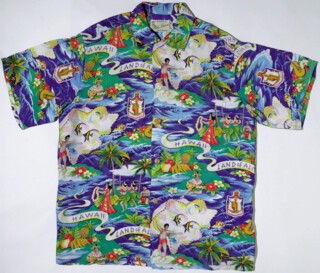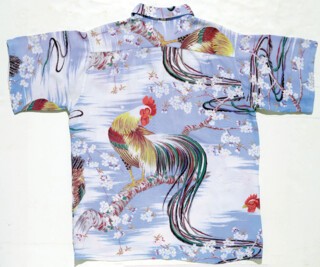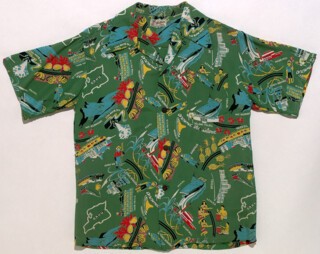Elvis was photographed in a Hawaiian shirt, so were Bing Crosby (he had his own label), Harry Truman and Walt Disney. They are beach wear – proof that you are on vacation. The style was developed in the 1920s and 1930s by local manufacturers: worn by both native and tourists, it was the dress of choice on the palm-fringed Hawaiian holiday beaches – a paradise which, the posters of the Matson Line promised, was only a few sea-days away from the US West Coast. You went ashore and more often than not bought a shirt – some even had pictures of your cruise ship surrounded by floral leis. The basic shape – square-cut, short-sleeved – isn’t so far from that of the long-sleeved loose ‘frocks’ the first European sailors wore. But although the shape is so simple it’s hard to say where it came from, the fabric designs can be traced to a dozen sources. To start with, there were the bold geometric patterns drawn on native Pacific fabric – tapa cloth, beaten out from the bark of the paper mulberry. In the 1920s, aloha shirts might be made from kimono lengths from Japan – elaborately printed silk or plain blue and white – or from big-patterned florals in English cotton, like the wrap-around pareus Gauguin’s Tahitian women wear. After that, locally designed – and locally printed – patterns, which might have the innocence of nursery wallpaper, the brilliance of fruit-box labels or the tackiness of tourist-brochure artwork, began to flourish. Confections of frangipani and pineapple, bamboo, surf and volcanoes make the brightest floral chintz look tame. The buttons of the true aloha shirt were cut from coconut shell. Collectors now comb thrift stores for masterpieces of printed rayon from the Golden Age – which they reckon runs up to around 1955. Chinese and Japanese tailors and entrepreneurs were among the early manufacturers; as the business got bigger, it became a significant part of the local economy and then spread to the mainland. Manufacturers world-wide have made their own versions with their own allusions: the Hawaiian shirt is no longer just a Pacific speciality.
In The Aloha Shirt by Dale Hope and Gregory Tozian, from which this information comes, the text flows among the pictures, much as slogans do among dancers, pineapples and palms on some of the shirts – ‘Do the hula,’ ‘Hawaiian hospitality’, ‘Beach at Waikiki’ and so on.* Alongside a picture of clerks from the Bishop National Bank of Hawaii ‘loosening up during Aloha Week’, one reads how in 1947 city employees were granted the right to wear them – and not just to wear them, but to wear them with the tail outside the trousers. It was the great Duke Kahanamoku (the father of modern surfing, Olympic and world swimming champion, film actor and official Ambassador of Aloha, as well as the name on a line of Hawaiian menswear) who apparently created the sports shirt – the habit of not tucking in had already begun – by having his cut short and tidied up so that it hung loose more neatly.
To untuck or unbutton is a gesture any shirt-wearer can make. Just back from one of the parts of France where members of the English middle class take their summer breaks and have their holiday homes, I have no memories of big florals: no surfboards, boats, fish and dancing girls (the pin-up on Tony Blair’s cuff was surely an anomaly), but the British on holiday have learned to untuck. The T-shirt, perhaps, or the dress of an Asian cornershop-keeper, has taught us how to accept that down south, where the sun is really hot and Ricard tastes OK, we should let it all hang out.
Loose, untucked summer clothes with fewer layers in floppier fabrics both reveal and flatter. They flow over paunches and make no definite statements about waists. The bronzed, even when they are old, can, if they are plump, afford to make more of a show of their flesh: what is exposed will suggest, at worst, a pleasing seal-like sleekness – the wrinkled, or pale northerners, pink or sunblock-pallid, may feel the need to cover up.
As we sat at a Paris café table, the most striking passing figure was an old woman – thin to the point of emaciation. At every shop window she checked out her reflection and her several diaphanous layers of bold, floral-printed skirt, top and shawl. Her hat was playful. She seemed dressed to pay brave if tattered tribute to wonderful summers past. With make-up which said more than was kind about failing eyesight, her get-up seemed to look back so far that you could imagine she remembered the days before sunbathing, Chanel and Scott Fitzgerald, when winter visitors fled the heat and the hotels on the Riviera shut for the summer.
It is a time Paris itself has forgotten. The plage they have created on the quay upstream from the Pont Neuf – a stretch of sand and an avenue of potted palms – is supplied with blue and white sunbeds on which sunbathers lie, burnt to shades of brown as dark and various as samples of woodstain.
I am told that Rome in the Shade, an early guidebook I have, alas, never seen, directs visitors who are unwilling to retreat during the heat of the day to routes which keep to the shady side of the street. Now, when you see children kitted out in flapped caps like little members of the Foreign Legion, and the pulse of the contracting and expanding ozone hole threatens to scorch us with invisible doses of ultraviolet, it seems possible that the future lies there – with those who creep in the shade, not those who expose flesh. Paris Plage, on that account, is a late swansong, a last homage to sun worship.
Send Letters To:
The Editor
London Review of Books,
28 Little Russell Street
London, WC1A 2HN
letters@lrb.co.uk
Please include name, address, and a telephone number.




